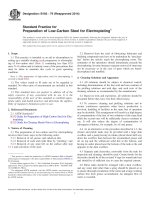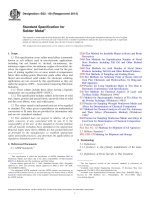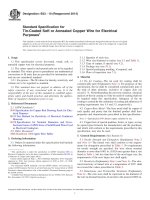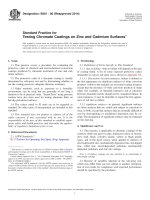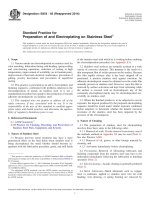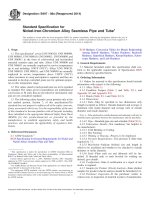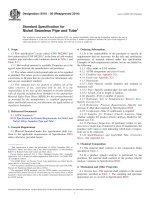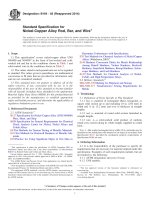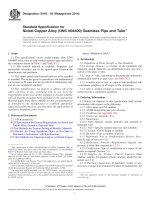Astm b 322 99 (2014)
Bạn đang xem bản rút gọn của tài liệu. Xem và tải ngay bản đầy đủ của tài liệu tại đây (120.83 KB, 9 trang )
Designation: B322 − 99 (Reapproved 2014)
Endorsed by American
Electroplaters’ Society
Endorsed by National
Association of Metal Finishers
Standard Guide for
Cleaning Metals Prior to Electroplating1
This standard is issued under the fixed designation B322; the number immediately following the designation indicates the year of
original adoption or, in the case of revision, the year of last revision. A number in parentheses indicates the year of last reapproval. A
superscript epsilon (´) indicates an editorial change since the last revision or reapproval.
This standard has been approved for use by agencies of the U.S. Department of Defense.
INTRODUCTION
This guide is intended to illustrate general principles of cleaning prior to electroplating. It is not
meant to apply to every specific application. In specific cases, cleaning practice may depart from the
general principles given in this guide.
Part I—Precleaning (use of a solvent, emulsion, or alkaline
spray) to remove the bulk of the soil.
Part II—Intermediate (alkaline) cleaning.
Part III—Final electrocleaning, to remove trace solids and
especially adherent impurities.
Part IV—Trouble shooting.
Often, depending largely on the amount and type of soil on
the workpieces as received, one or more of these stages may be
eliminated or modified. Usually, even with light soils, it is
advisable to retain multistage cleaning, thereby increasing the
life and efficiency of the cleaning solutions.
1.5 This standard does not purport to address all of the
safety concerns, if any, associated with its use. It is the
responsibility of the user of this standard to establish appropriate safety and health practices and determine the applicability of regulatory limitations prior to use. (For more specific
safety precautionary statements see Sections 11 and 16.)
1. Scope
1.1 This guide describes the procedure for cleaning metal
surfaces to obtain good adhesion of electrodeposited metals.
The degree of cleanliness required for metals to be electroplated is greater than for most other finishes. Methods of
removal of heat-treat or mill scale are not included in these
methods, because they are covered in practices referring to
specific metals. It should also be understood that while these
procedures are broadly applicable, particular substrates may
require certain specific cleaning procedures.
1.2 Adequate cleaning requires a proper combination of
cleaning procedures. The choice of these procedures must be
based on a knowledge of the metals to be cleaned and of the
soils to be removed. Because most experience and knowledge
in cleaning have been obtained by suppliers of proprietary
processes and formulations, these sources should be consulted
before setting up a cleaning process.
2. Significance and Use
1.3 A treatment to remove tarnish, light rust, fingerprints, or
oxides is usually provided before immersion of the piece in the
electroplating tank. This treatment activates the metal and is
usually accomplished in acid baths which also serve to
neutralize the residual alkaline film from alkaline cleaning.
Alkaline chelated derusting and cleaning solutions, alone or
with sodium cyanide, used as a soak or electrocleaner, are often
preferred before electroplating on ferrous alloys.
2.1 The performance and quality of electroplated articles
depend upon the surface cleanliness and condition. Various
metals are electroplated for decorative or engineering finishes.
The common electroplates applied are usually copper, nickel,
and chromium for decorative and functional uses. Electroplated articles are used in many industries such as the marine,
automotive, plumbing fixtures, and appliance industries.
1.4 Invariably several stages are necessary to provide adequate cleaning. These stages are discussed in three parts:
3. Nature of the Soil
3.1 Some of the soils commonly encountered in electroplating are:
3.1.1 Solid buffing compounds containing waxes, fatty
acids, and abrasives.
3.1.2 Liquid buffing compounds.
3.1.3 Drawing and stamping compounds including those
containing fillers (pigments).
1
This guide is under the jurisdiction of ASTM Committee B08 on Metallic and
Inorganic Coatings and is the direct responsibility of Subcommittee B08.02 on Pre
Treatment.
Current edition approved Nov. 1, 2014. Published November 2014. Originally
approved in 1958. Last previous edition approved in 2009 as B322 – 99(2009). DOI:
10.1520/B0322-99R14.
Copyright © ASTM International, 100 Barr Harbor Drive, PO Box C700, West Conshohocken, PA 19428-2959. United States
1
B322 − 99 (2014)
5. Cleaner
3.1.4 Machining oils.
3.1.5 Rust-preventive slushing oils or greases.
3.1.6 Electroplater’s stop-off residues.
3.1.7 Fingerprints.
3.1.8 Dry dirt from storage or dry pickling smut formed
during derusting by pickling.
3.1.9 Rust or oxide scales, especially admixed with oil,
including heat-treat scales after oil quenching.
3.1.10 Phosphate coating with or without lubricant.
3.1.11 Smut resulting from improper vapor degreasing of
heavily buffed work.
3.1.12 Smut resulting from annealing parts without precleaning between drawing operations.
3.1.13 Heat-treating salts, with or without quenching oils.
5.1 It is essential that proper cleaners and operational
conditions be selected. Attention should be given to proper
procurement since, even in the same category, not all cleaners
are equally effective. A cleaner may be very effective for one
group of soils, yet poor for other soils. This is true of
electrocleaners as well as soak or spray cleaners. Soil, type of
water, available time, rinsing facilities, type of metal, heating,
and agitation available, facilities for disposal of cleaner, and
type of personnel and equipment all influence the selection of
cleaners. Obviously, economics must be considered but an
initial or per pound cost must be balanced against other factors.
5.2 Cleaners do not work effectively indefinitely. The effective life of a cleaning bath must be estimated and baths
discarded when exhausted. Bath life is influenced by some of
the factors mentioned above as well as by the volume of work
processed. The concentration of the cleaner should be controlled by analysis at regular intervals.
3.2 Consideration should be given to control of the soil. For
example, efforts should be made to avoid overbuffing, leaving
excessive compound on the work, or aging of the compound on
the part before cleaning. Substitution of liquid for solid buffing
compound, if work permits, often gives easier cleaning, if
properly applied, but may require use of a different type of
cleaner. Drawing compounds with polymerizing oils or white
lead pigment are to be avoided because of difficulty in
cleaning. Additives for lubricating and sulfurized cutting oils
are chosen for their ability to adhebe tenaciously and are
difficult to remove. Prolonged storage or drying of emulsion
drawing compounds after metal working should be avoided so
that slimy water-in-oil emulsions do not form. In-process
cleaning or even a hot-water flush before storage is helpful.
Emulsion machining lubricants (soluble oils) should be used in
place of sulfurized cutting oils if operations permit. Lowerviscosity machining and rust-preventive oils are more easily
removed. Stop-off materials, when used, should be applied
carefully in order to avoid contaminating significant surfaces.
The use of clean gloves should be mandatory after buffing or
polishing to avoid fingerprints on the work. Airborne contaminants can be avoided by using covers over stored work. It is
desirable to perform a cleaning operation as soon as possible
after metal forming, polishing, or buffing to reduce the demands on subsequent cleaning operations, because many soils
are more easily removed when fresh.
6. Rinses
6.1 Water hardness, acidity or alkalinity, and impurities are
important factors in rinsing (1).2 Distilled or demineralized
water is preferred where impurities in rinse water must be kept
to a minimum. Boiler condensate may also be used advantageously. If the plant conditions water for acidity or alkalinity
care must be taken to be sure the solids content is not too high
(Note 1). Impurities derived from processing cannot be ignored; that is, rinse waters must be changed frequently or
overflowed continuously (Note 2). Counterflowing rinses are a
distinct advantage in obtaining good rinsing with economical
use of water.
NOTE 1—Boiler waters which contain cationic corrosion inhibitors may
be quite detrimental to the plating process.
NOTE 2—Floating oil on water can cause poor adhesion.
7. Equipment
7.1 It is important to provide enough room in the plant for
an adequate cleaning cycle. A discussion of equipment is
beyond the scope of this practice (2, 3).
8. Criteria of Cleanliness
4. Metal
8.1 This subject has been treated exhaustively in the literature (4). The atomizer test is the most sensitive one, but the
water-break test is most commonly used. This involves visual
observation after a final rinse in clear, cool water. A continuous
sheet of water on the part usually indicates a clean surface.
(Certain precious-metal surfaces, such as gold, may exhibit
water break, even though clean.) Some experience is necessary
to judge the appearance of a break in the film of water. A
specific drainage time, about 30 s, should be used before
observation.
4.1 The properties of the metal and the method of fabrication and handling of parts play a role in cleaning. The softness
and surface finish of the metal are factors in selecting handling
methods. The chemical activity of the metal is an important and
determining factor in cleaner selection. Aluminum requires
care to avoid overetching in alkaline cleaners; both aluminum
and zinc are sensitive to pitting attack, zinc and brass to
tarnishing. Zinc die castings have surfaces that require special
care because of sensitivity to attack by cleaning solutions. If
possible, design of parts should avoid small indentations that
tend to trap solid particles or buffing compositions. With die
castings, care must be exercised to avoid cutting through the
surface by excessive buffing. The subsurface is usually more
sensitive than the“ skin” of the casting. Some surface defects
may not show up until cleaning and electroplating cycles are
completed.
8.2 A dip in clean, dilute acid and reexamination are
desirable to avoid false water-film continuity due to adsorbed
soaps. Other methods, including electroplating and testing of
2
The boldface numbers in parentheses refer to the reports and papers appearing
in the list of references at the end of this practice.
2
B322 − 99 (2014)
metal chips and dust, etc.) are flushed away as the soluble soils
(greases and oils) dissolve in the solvent. It is not effective on
metallic salts, scale, carbon deposits, many inorganic soldering
or welding fluxes, and fingerprints unaccompanied by oil or
grease. This process is frequently competitive in cost with wet
cleaning methods. Its lower equipment, floor space, and heat
requirements offset the higher cost of solvent.
10.3.3 For some applications (steel stampings, buffed zincbase die castings, etc.), the degreased work can go directly to
mild electrolytic cleaning and subsequent electroplating without the need for an intermediate alkaline cleaning step.
the electroplate, should be used occasionally to confirm visual
examination. (One procedure involves scrubbing with pumice
and then comparing the surface produced by this method with
that produced under production conditions.)
PART I—PRECLEANING
9. Purpose
9.1 Precleaning is designed to remove a large excess of soil,
especially deposits of buffing compound or grease. It is also
useful in reducing the viscosity of waxes and heavy oils, to
enable later cleaning stages to be more effective, or to surround
fingerprints and dry dust with an oily matrix to facilitate
removal by alkaline cleaners.
10.4 Emulsion Cleaners—Oils and high-boiling hydrocarbons such as kerosene have the ability to dissolve most greases,
particularly at high temperatures. The addition of emulsifiers,
soaps, and wetting agents enhances the penetrating power of
the organic solvent and permits removal of the latter and
associated soil by power flushing. Further, intimate contact of
the metal surface with the aqueous phase permits removal of
materials not soluble in the hydrocarbon phase.
10.4.1 The principle of emulsion cleaning can be applied in
a variety of ways including the use of straight emulsifiable
solvents, unstable emulsions (diphase cleaners), invert-type
emulsion cleaners, and stable emulsions. Additions of rust
inhibitors or of alkali cleaners can be made to the water phase.
Since agitation is important to good cleaning, the power-spray
cleaners find wide applications.
10.4.2 Emulsion cleaners are used at temperatures up to
82°C. The higher temperatures remove soils more quickly and
effectively, but caution must be used with cleaners containing
organics of low flash point. Some cleaners containing chlorinated solvents are used above the flash point of some of the
components since the chlorinated portion will volatilize to
extinguish flashes.
10. Types
10.1 Cold solvent, vapor degreasing, emulsifiable solvent,
solvent emulsion spray, invert-type emulsion cleaners, or hot
alkaline spray with or without solvent emulsion can be used
(5).
10.2 Cold Solvent (6)—Mineral spirits; trichloroethylene;
perchloroethylene; 1,1,1,-trichloroethane (methylchloroform);
methylene chloride; or trichlorotrifluoroethane can be used for
cold cleaning. Combining these with hand brushing is excellent
but does not lend itself to production conditions. On the other
hand, simple dipping in solvent is frequently ineffective. The
chlorinated solvents are very effective for many soils, but not
as effective in removing soap-based or other solvent-insoluble
soils. Before electroplating, cold cleaning with solvents must
be followed by additional cleaning such as alkaline cleaning to
remove slight oily residues.
10.3 Vapor Degreasing (7)—Trichloroethylene and, to a
lesser extent, perchloroethylene, trichlorotrifluoroethane, and
methylene chloride are used for vapor degreasing. In vapor
degreasing, the work is usually sprayed with clean solvent or
given a thorough immersion in boiling or warm solvent for
mechanical removal of tenacious soil or solids. This is followed by immersion in cold solvent to cool the parts. Then
follows exposure to condensation of hot, clean solvent vapors
on the work. This final step also removes any last traces of oil
and grease and dries the part. For removal of caked-on oils and
compounds, a predip in cool solvent can be used to wet and
loosen the soil before the degreasing operation.
10.3.1 Vapor degreasing can be used to clean all types of
metal, including steel, steel alloys, light metal alloys, special
bronze, nonferrous metals, nickel, and titanium. This method
simplifies the cleaning of parts containing several metals
because it cleans by solvent action instead of chemical action;
there is no danger of over-cleaning or under-cleaning because
of any difference in chemical activity of the metals present.
Because of the rapid penetrating action of the solvent and
solvent vapor, this method is effective in cleaning parts
containing recesses, blind holes, perforations, crevices, and
welded seams. Where the soils are present on surfaces that are
not readily accessible, the process is sometimes supplemented
by ultrasonic cleaning in the solvent rinse chamber.
10.3.2 Vapor degreasing is effective on solvent-soluble soils
and chemically active lubricants. Insoluble soils (buffing grits,
10.5 Biological Cleaners (8)—Highly emulsifying soak
cleaners are combined with living microorganisms to permit
the removed oils, greases, and other complex organic compounds to undergo a natural process known as bioremediation.
Living microbes break down organic compounds, such as oil
and grease into carbon dioxide and water and the cleaners, if
properly maintained, may run for years without changing the
bath at all. Since the cleaning fluid is kept free from
contaminants, the such systems allow more effective cleaning
for a greater length of time.
10.5.1 In order to maintain a healthy biosystem, operating
conditions are critical. Typically, optimum pH range for these
types of cleaning systems is 8.5 to 9.5. Too high a pH will
result in lowering of the bacteria action, and oil will be
built-up. Too low a pH will render the bacteria too active
resulting in consumption of the wetter and other organics
necessary for proper cleaning. Temperature also is a critical
operating parameter. Optimum metabolism of oil and grease is
achieved around 40 to 50°C.
10.5.2 Air agitation is critical to maintaining an oxygenated
environment to maintain sufficient biological activity and only
aerobic bacteria. Without air during operation, anerobic bacteria are produced and the cleaner will take on a noticeable,
unpleasant odor. Air sparging also improves overall cleaning
efficiency by promoting transfer of oil and grease particles
3
B322 − 99 (2014)
PART II—INTERMEDIATE (ALKALINE) CLEANING
from part surface into the cleaning solution. In order for
bioremediation to proceed, particles must be detached from the
part surface.
12. Purpose
12.1 Intermediate alkaline cleaning removes solvent residues and residual soil which has been softened or conditioned
by precleaning. Spray or soak alkaline cleaning also can be
used as a precleaning stage followed by additional alkaline
cleaning, if the soil and metal lend themselves to this treatment.
This is not so for metals that are sensitive to alkaline cleaning,
such as zinc, because the time in the alkaline cleaner should be
minimal. Some electroplaters use the term precleaning for
alkaline cleaning before electrocleaning, especially when solvent cleaning is carried out at a different part of the plant.
11. Precautions
11.1 The use of solvents and emulsions of diphase cleaners
requires special attention to safety hazards. Petroleum and
aromatic solvents of low flash point, for example less the 55°C,
must be used with caution. Underwriters Laboratoriesapproved containers and adequate ventilation should be provided to avoid the accumulation of fumes in explosive concentrations. Diluted emulsion cleaners usually have flash points
above 70°C and emulsifiable solvents of high flash point are
now available.
12.2 Although industrial practice is limited, vapor degreasing alone is sometimes used before electrocleaning. Most oils
and greases and some buffing and drawing compounds are
effectively removed and contamination of the electrocleaning
bath is lessened. The specific applications will not be given in
detail here (5, 6, 7). Manufacturers of degreasing solvent or
equipment should be consulted for details.
11.2 Trichloroethylene and perchloroethylene are nonflammable under the conditions of the vapor degreasing process and
are among the least toxic of the chlorinated hydrocarbons; up
to 100 ppm of either is tolerable in the working atmosphere for
a normal 8-h working day. Trichlorotrifluroethane (1000 ppm
tolerable limit) is also used. With proper equipment design and
operation, solvent vapors in the working area are easily
maintained well below recommended safe limits. Degreaser
tanks should preferably be cleaned and maintained from
outside the tank. Entry into a tank should be made only after all
solvent and vapors have been removed and then only with an
observer on the outside. Proper ventilation cannot be overstressed because workmen will often discard a recommended
gas mask. For cold-solvent operations, adequate ventilation
must be provided in the work area.
13. Types
13.1 Soak alkaline cleaning is carried out at 30 to 120 g/L of
alkaline cleaner at temperatures of 82°C to boiling, for periods
of 3 to 15 min. If used ultrasonically, temperatures may be
70°C to boiling. The cleaners usually contain surface-active,
soap-like materials which foam if agitated vigorously.
13.2 Spray alkaline cleaning is usually carried out at 4.0 to
15 g/L at temperatures of 50 to 82°C for 1 to 3 min with spray
pressures of 69 to 345 kPa (10 to 50 psi). Foaming may be a
problem, unless the cleaner is properly designed.
13.2.1 Foam is also a major problem because of accumulation of soaps in the cleaner from the action of the alkali on
some organic soils and drag-in of wetters from precleaners. For
this reason, it frequently is desirable to use low concentrations
of cleaner, for example, 4.0 g/L, and to discard the solution
often, even though cleaning is adequate. For the same reason,
it is sometimes necessary to operate at lower pressures even
though higher pressures give better cleaning.
11.3 Because soils accumulate in solvents, the solvents must
be discarded or purified by distillation. In vapor degreasing
equipment, the solvent is recovered by distillation and the soil
discarded. The use of automatic auxiliary stills in conjunction
with the degreaser allows continuous cleaning operation and
solvent recovery.
11.4 Emulsifiable solvents must be discarded occasionally,
although frequently most of the soil is flushed off in the rinse.
Emulsion cleaners represent a particular problem of bath
contamination because of the lack of adequate analytical
controls to determine bath life. Because emulsion cleaners
yield a water-shedding surface, the effect on water-break due to
accumulated oils is difficult to differentiate from that due to the
solvent. Because of the low cost of diluted emulsion cleaners,
it is economical to discard these baths at frequent intervals.
Soap-base emulsion cleaners can cause difficulties where
acidic soils are introduced; here mixed alkalies and emulsion
cleaners can also require water conditioning in hard-water
areas to avoid precipitation of hard-water soaps. Good housekeeping is desirable to avoid bacterial contamination of emulsion cleaners. Bacteriostats can be included in the formulations
of cleaners to prevent the unpleasant odors that result from
bacterial action.
13.3 Barrel alkaline cleaning is usually carried out at 7.5 to
45 g/L. Temperatures are usually lower than for soak cleaning
because of mechanical factors. Although agitation is better than
in some cleaning, control is frequently not as good.
14. Factors Influencing Good Alkaline Cleaning
14.1 Concentration—The optimum concentration of the
cleaning solution should be determined by actual tests because
many factors are involved.
14.2 Temperature—Best results are obtained near the boiling point if other conditions permit. The high temperature
reduces the viscosity of the soil. A rolling boil provides
agitation. In some cases, cleaner formulation may be such as to
make lower temperatures optimal.
14.3 Time—Alkaline cleaners, operating by the mechanism
of lifting the oil film, require a reasonable time to permit the
surface-active materials to act on the surface. This time is
11.5 As indicated in 14.7.8, disposal of emulsion cleaners
can present problems.
4
B322 − 99 (2014)
clean water hit the work as it exits from the rinse tank. Drying
of the cleaner on the work before rinsing should be avoided by
having fog nozzles after cleaning tanks, if necessary, or by
decreasing transfer time or operating temperatures. With some
cleaners, adequate rinsing is difficult to obtain after the cleaner
has dried on the work.
shortened if agitation is vigorous, temperatures high, and
concentration high. Age of solution and contamination retard
cleaning.
14.4 Agitation:
14.4.1 Spray Cleaning (2)—As in emulsion cleaning, much
of the effectiveness of spray cleaners in removal of solids is
due to the mechanical action of the solution sprayed on the
surface. Hence, every effort should be made to obtain efficient
impingement at high pressure without pushing the work out of
the spray area (or off the racks). Foaming after soap accumulation also limits spray pressure. The action of spray alkaline
cleaners depends on detergency as well as mechanical action;
the proper materials and conditions should be used. Spray
nozzles should not be allowed to clog with solids and vestibules should be provided at each stage of the machine to avoid
contamination by overspray. Agitation is very good in spray
cleaning (if the sprays hit the solid surfaces directly).
14.4.2 Soak Cleaning (3)—Suggested methods of agitation
in soak cleaning are as follows:
14.4.2.1 Complete withdrawal and reimmersion, especially
at about half the total time allotted in the cleaner,
14.4.2.2 Pumping the solution over the work with proper
intake and adequate pressure.
14.4.2.3 Rapid motion of the work in the cleaner,
14.4.2.4 Maintenance of a rolling boil,
14.4.2.5 Use of an air line or a mixer,
14.4.2.6 Ultrasonic agitation, and
14.4.2.7 Use of an overflow weir assists in separating
unemulsified oils, grease, and other solids.
14.7 Selection of the Cleaner—Important factors to be
considered are as follows:
14.7.1 Soil (see 3.1 and 3.2)—If the soil is rich in soaps, the
cleaner should be lean in this respect and should have built-in
high soap tolerance. Because of the specific action of the
individual cleaners on certain soils, this is a prime factor in
cleaner selection.
14.7.2 Metal (see 4.1)—Special cleaners are designed to
avoid harmful effects on zinc, aluminum, and brasses. Iron,
steel, magnesium, and copper have better tolerance to alkaline
cleaners.
14.7.3 Water—Hard water frequently requires cleaners rich
in water softeners, such as sequestering and chelating agents,
largely to prevent difficulties during rinsing.
14.7.4 Method of Application (4)—There is no universal
cleaner that can be efficiently applied by all methods of
cleaning. The cleaner should be formulated for its method of
application. Cooperation of purchaser with vendor in permitting study of equipment, and availability of heating facilities
will minimize problems such as incomplete cleaning, excessive
foaming, dry down of cleaning solution before rinsing, etc.
14.7.5 Degree of Cleanliness Required (5)—The degree of
cleanliness required for the next operation should be determined by the purchaser and explained to the vendor. If parts are
to be held over between operations, a light oil or alkaline
protective film may be advantageous to prevent rusting. Parts
going immediately to electroplating should be free from any
objectionable films that might prevent adhesion of electrodeposits.
14.7.6 Unit Cost—Many factors enter into the cost of a
cleaning operation. Among them are: yearly cost of space
occupied by the equipment, capital costs and amortization of
equipment, utilities (water, heat, power, etc.), maintenance by
laboratory control, make-up, additions, and disposal of spent
solutions, labor, cost of cleaning compounds, and cost of
reprocessing rejects. To obtain true costs per thousand square
feet of work processed all these factors must be included.
14.7.7 Safety—Consideration must be given to the safety of
operators and equipment and parts being cleaned (see 11.1,
11.2, 11.3, and Section 16).
14.7.8 Disposal of Spent Solutions and Rinse Waters—
Local, state, and Federal regulations must be consulted before
final selection of a cleaning material can be made. Increasing
attention to reduction of stream pollution throughout the
country means that this factor is a more decisive one in
selection of cleaning materials. Examples of materials that
come under such regulations are: chromates, cyanides, nonbiodegradable detergents, phenolics, spent solvent emulsions, and
phosphates.
NOTE 3—Electrocleaning represents a special method of agitation and is
considered in 15.4.
14.5 Age and Degree of Contamination—A long bath life is
desirable, not only for economy but also to avoid the necessity
for constant supervision. Alkaline cleaners vary in this respect;
much depends on the amount of soil present on the work being
cleaned. Care must be taken to avoid redeposition of the soil as
parts exit from the cleaner. Cleaners should be discarded
periodically because of accumulation of debris, etc. Surface oil
should be skimmed frequently, preferably by overflowing into
a properly designed skim trough. The cleaner should be
buffered to have a high tolerance for acidic soils. Tolerance for
soaps, formed by reaction with the soils, can be designed into
the cleaner when necessary.
14.6 Rinsing (see Section 6)—Double rinses are desirable to
reduce the concentration of cleaner in the rinse. A first hot rinse
gives more efficient cleaner removal, while a second cold rinse
reduces the tendency to rusting and tarnishing during transfer
to the next stage. If rinsing is inadequate, the components of
the cleaner must be selected to promote easy rinsing. Selection
of a free-rinsing cleaner may require some sacrifice in cleaning
properties. Rinse tanks should have adequate overflow rate,
skimming troughs of good design, and proper positioning of
the intake water line.
14.6.1 Agitation of work in the rinse tank is desirable. Water
must also flow through hot rinses, although a reduced rate is
often desired for economy. Spray rinsing is very effective,
especially if coupled with soak rinsing by having a spray of
5
B322 − 99 (2014)
15.4 Electrocleaners:
15.4.1 High electrical conductivity is essential. Sodium
hydroxide alone could impart this property, but it lacks the
detergent action to remove oils, greases, and solid particle
soils. Therefore, other materials must be incorporated with the
sodium hydroxide.
15.4.2 Wetting and emulsifying action supplied by nonionic
(low-foaming) and some anionic surface-active agents are
required to increase solubility of the nonionics. These must be
in sufficient quantity to wet and emulsify residual oil and
grease films remaining from precleaning operations. However,
their concentration must be low enough to prevent excessive
foaming caused by the evolution of hydrogen and oxygen at the
electrodes. The type of foam produced should be “brittle,”
rather than tenacious, and short lived, but be able to prevent
annoying spray from the alkaline solution from escaping into
the atmosphere. The organic surface-active agents chosen
should not be decomposed into tarry residues by heat, high
alkalinity, or oxidation at anodes. They should have a minimum tendency to “deposit out” on the electrodes.
15.4.3 Deflocculating or colloidal properties are necessary
to suspend solid particle soils removed from the work in a
free-rinsing condition. Again, these agents should have a
minimum tendency to “deposit out” on the electrodes.
15.4.4 Water-softening ability is required to prevent formation of insoluble soaps by combination of hard-water salts with
soaps formed by reaction of soils and alkaline constituents.
Such insoluble soaps adhering to surfaces decompose in
subsequent acid dips and leave objectionable films of fatty
acids on parts to be electroplated. The sequestering polyphosphates are used for this purpose where operating temperatures
do not exceed their decomposition range, about 80°C. The
organic chelating agents are stable and offer another advantage
over the polyphosphates in that they solubilize light oxide films
on the metal parts and provide a more active surface for
subsequent electroplating.
15.4.5 Buffering action is required in electrocleaners as in
other types to maintain the optimum pH range, despite introduction of acidic soils.
15.4.6 Inhibition to prevent attack of sensitive metals is
required for the undesirable condition where a single electrocleaning solution is used as a precleaner and final cleaner. On
ferrous alloys no inhibition is required. Where sensitive metals
have been precleaned, a slight attack or oxidation of the
surface, when anodically cleaned, is considered beneficial.
This action, plus subsequent acid dip, before electroplating,
removes disturbed metal surfaces and promotes better adhesion.
15. Formulations of Alkaline Cleaners (8)
15.1 General—Actual compositions of cleaning materials
for various metals, soils, methods of application, degree of
cleanliness required, and other specific conditions are beyond
the scope of this document. The fact that individual suppliers of
proprietary cleaning materials have hundreds of standard
products available indicates the complexity of this field. In like
manner, the recommendations for their application vary
widely. Some requirements for formulations of cleaning materials are listed below:
15.2 Soak Cleaners:
15.2.1 Ability to saponify animal and vegetable oils, if
conditions such as paint stripping require it on steel parts.
Otherwise, this requirement can be undesirable where sensitive
metals are involved, because attack on the metal may occur
thereby.
15.2.2 Wetting and emulsifying action supplied by soaps or
synthetic surface agents to wet oily and greasy deposits and,
with agitation, suspend the deposits in an emulsified state until
rinsing is accomplished.
15.2.3 Deflocculating action or colloidal properties to attract solid particle soils and suspend them in a free rinsing
condition, so that redeposition of the soil is prevented.
15.2.4 Water-softening ability to sequester or chelate calcium and magnesium ions by combining with them to form
water soluble nonionic complexes.
NOTE 4—Use of polyphosphate-type sequestering agents is limited to
temperatures below 80°C, because decomposition into orthophosphates
occurs above this temperature. Organic chelating agents are stable to
above 100°C. Chelating agents also have the ability to form water-soluble
complexes with di- and trivalent insoluble metallic salts, such as iron
oxides. Thus, specially compounded soak cleaners can remove rust, heat
scale, and iron or zinc phosphate deposits as well as oily or other soils.
15.2.5 Buffering action to maintain the optimum pH range,
despite introduction of acidic or alkaline soils.
15.2.6 Proper inhibitors for prevention of attack of sensitive
metals.
15.3 Spray Cleaners:
15.3.1 The short duration of spray washing operations
generally precludes necessity for inclusion of saponifying
action.
15.3.2 Wetting and emulsifying action is incorporated in
this type of cleaner, but to a much lesser degree than in soak
cleaners, to prevent excessive foaming. Special low-foaming
surface-active agents are generally used. Otherwise, antifoaming ingredients are a part of the formulations.
15.3.3 Deflocculating action, or use of colloidal materials, is
beneficial in suspending solid particle soils. However, unless
properly compounded, they can cause excessive foaming.
15.3.4 Water softening to prevent formation of insoluble
calcium scales on heating coils, spray nozzles, etc., is a
necessary requirement of these cleaners.
15.3.5 Because of the large area of work going through
spray washing machines and the lower concentrations of
cleaner used, buffering action is an essential part of a spray
cleaner, to maintain effective life.
15.3.6 Depending on the type of metal parts being cleaned,
an inhibitor may or may not be required.
16. Precautions (9)
16.1 Some alkaline cleaners generate considerable heat
when dissolved in water. Rate of solution, however, is frequently very slow in cold water. It is most advantageous to
have the water at a temperature of about 50°C while the cleaner
is carefully sprinkled in small quantities over the surface of the
tank, as with a shovel. Others prefer the safer but slower
process of adding the cleaner directly to the tank of water at
room temperature with provision for agitation to avoid caking.
6
B322 − 99 (2014)
A caked cleaner dissolves slowly. If alkali gets on the skin, it
should be washed profusely with water and medical attention
received promptly.
NOTE 5—Nonferrous metals are tarnished or attacked if anodic cleaning
is prolonged in an uninhibited electrocleaning solution. However, this
action may be beneficial as discussed in 15.4.6. Alloys of lead, nickel, or
silver and nickel, and silver electroplated surfaces should not be anodically cleaned. Lead alloys are rapidly attacked and nickel and silver
surfaces become passivated, requiring special activating treatments for
subsequent electrodeposits.
PART III—FINAL ELECTROCLEANING
17. Purpose
18.4 Periodic Reverse (PR) Current Cleaning—A modification of normal electrocleaning methods is the use of a number
of cycles of periodic reverse current to assist in removal of
soils, instead of a single application of direct or reverse current
cleaning, or a combination of them. Details of electrical
equipment for production of periodic reverse current are
outlined in a recent book (11). Users of PR cleaning, unlike PR
electroplating, prefer a PR cycle in which the cathodic (directcurrent) time equals the anodic (reverse-current) time. To
prevent deposition of loose metallic smuts, the work should be
removed from the electrocleaner during the deanodic portion of
a cycle. PR cleaning gives improved smut removal, accelerates
cleaning operations, and provides a more active surface for
subsequent electroplating (12). PR cleaning improves electrolytic removal of rust and scale in alkaline chelating solutions
(13).
17.1 The objectives of metal cleaning before electroplating
have been summarized as follows (10): In electrodeposition a
surface is required which will receive a smooth, adherent metal
deposit, but this is not necessarily an absolutely clean surface.
In general, an acceptable surface is one on which objectionable
surface films have been replaced by films more suitable and
acceptable for electroplating.
17.2 Assuming that the metal parts have been precleaned by
methods described above, the “objectionable surface films” are
precleaner residues, minor amounts of soils such as oils and
solid particles not completely removed by previous cleaning
treatments. Thus, the final electrocleaning process is insurance
that only films remain that are“ more suitable and acceptable”
for the electroplating operations.
18. Types of Electrocleaning
PART IV—TROUBLE SHOOTING
18.1 Electrocleaning is soak cleaning with agitation provided by the upward movement of bubbles of hydrogen or
oxygen formed by the electrolytic decomposition of water in
the solution. Because of this electrolytic action special types of
cleaners are required (see 15.4).
19. General
19.1 Trouble in cleaning may be quite obvious or may be
very obscure. Electroplating operations generally are complex
and consist of many steps, so that very often it is not obvious
whether trouble is due to cleaning or some other phase of the
electroplating operation. It can be accurately stated, however,
that many electroplating troubles can be traced to faulty
cleaning. When trouble occurs and faulty cleaning is suspected,
an initial close observation of the work should be made after
each cleaning and rinsing step. Things to look for are water
breaks (especially after acid dips), excessive darkening or
etching, smuts, irregularity in appearance, and stains. Good
lighting is required for accurate observation, and also, the
observer should be one who knows from experience how
correctly cleaned parts should look after each cleaning step.
Parts emerging from rinses and acid dips should also be
examined for evidence of films either being picked up or not
being removed.
18.2 Cathodic—Parts negatively charged in the electrocleaner tank are cathodically or direct current cleaned. Hydrogen gas is evolved on the surface. Positively charged ions and
colloids are attracted to the cathode.
18.2.1 Cathodic cleaning provides greater agitation be cause
two volumes of hydrogen are evolved on the surface, as
compared with one volume of oxygen at the anode. In cathodic
cleaning, little or no tarnish or attach of nonferrous metal
occurs.
18.2.2 Cathodic cleaning attracts positively charged metallic ions, soaps, and other colloidal materials in the solution
causing them to“ deposit out” as loose smuts on parts being
cleaned. Since hydrogen is evolved on the parts it may
penetrate and become occluded in hardened steel parts, causing
embrittlement. Cathodic electrocleaning solutions are more
sensitive to chromic acid contamination than anodic electrocleaning solutions.
19.2 Cleaner concentrations and any special standards recommended by the supplier such as pH also should be
determined, along with tank temperatures, the possibility of
tanks being skipped if it is a hand line, the current density in
electrocleaners, polarity, time in tanks, and transfer times.
These all have a bearing on the proper functioning of cleaners.
If any of these have been changed, they are to be considered a
possible source of the trouble.
18.3 Anodic—Parts positively charged in the electrocleaner
solution are anodically or reverse current cleaned. Oxygen gas
is evolved on the surface. Negatively charged ions and colloids
are attracted to the parts.
18.3.1 A higher degree of cleanliness is obtained owing to
the “deplating” action resulting from the positively charged
surface repelling positively charged metallic ions, soils, and
smuts. Oxygen gas does not enter metals as hydrogen does.
Anodic electrocleaning solutions have much more tolerance for
chromic acid contamination.
18.3.2 Less agitation occurs at the anode surface because
only one volume of oxygen gas is evolved from the decomposition of the water.
19.3 The nature of the soils being removed must also be
considered. If buffing or drawing compounds or oils have
changed, the new soils may be more difficult to clean.
Sometimes a change in soils may require a change in cleaners
or a change in the method of cleaning. Likewise, a substantial
increase in the quantity of soil, such as buffing compound,
could cause trouble.
7
B322 − 99 (2014)
20.3.2 Bus Bars—Be sure that the bus bars are of ample size
to carry the current required for a work load (normally 158
A/cm2. cross section of copper bar). Be sure that the bus bars
are clean to ensure good contact.
20.3.3 Polarity—Be sure that the polarity is proper for the
job. Cathodic cleaning should seldom be used as a final
electrocleaning step because of the danger of “depositing out”
dissolved metals. There are exceptions to this rule, as in
electrocleaning lead, magnesium, nickel, silver, and some
stainless steels. If doubt exists as to polarity, check with a
voltmeter, or trace back the conductors to the current source.
20.3.4 Insulation—Be sure that the tank is insulated from
the floor, and that the work, electrode rods, and electrodes are
insulated from the tank. Insulated joints on steam, drain, and
water lines should be provided.
19.4 One good way to establish whether cleaning is the
cause of the trouble is to hand scrub a few parts with a bristle
brush and pumice powder, rinse, and then place them directly
in the electroplating solution without cleaning or acid dipping.
If the same trouble is evident on these parts, it can usually be
concluded that the trouble is in the electroplating baths or
elsewhere and not in the preparatory part of the cycle.
20. Detecting Trouble in Specific Cleaning Operations
20.1 Soak or Hot Still-Tank Cleaning:
20.1.1 Heating—Check the temperature. There should be
sufficient heating capacity to keep the solution at the proper
temperature during full production. If steam coils are used,
check for leaks diluting the solution. Check that the heating
element is not insulated from the solution by scale or sludge.
Check the operation of the thermostat.
20.1.2 Agitation Shield and Overflow Dam—The solution
should be properly agitated by bringing fresh cleaner solution
continuously to the work. The soils should be skimmed from
the solution surface over the dam.
20.1.3 Contamination—Heavier production can cause undue soil loading of the cleaner. Check the age of the cleaner.
Investigate introduction of any new soils that might cause the
cleaner to become exhausted prematurely.
20.4 Rinses—Rinses should be kept clean and overflowing.
Some cleaners require warm rinses for maximum efficiency.
The cleaner supplier’s instructions should be followed. It is
poor practice to use a common rinse tank for several purposes,
such as following a soak cleaner, electrocleaner, and an acid
dip. Air agitation in rinses is beneficial.
21. Failures Attributable to Cleaning
NOTE 6—There are a number of other reasons for these failures, not
associated with cleaning.
21.1 Blisters, Peeling, or Poor Adhesion—These defects
may be caused by improper polarity in the electrocleaner,
overcleaning (current density too high or cleaning time too
long), no current in the electrocleaner, and oil and grease not
completely removed. In certain circumstances, especially with
materials used in the electronic industry, such electroplating
defects may arise from other factors as well.
20.2 Spray Washing Machines:
20.2.1 Heating—Check thermostats, scale on heating coils
or tubes, and solution temperature. Descale the machine, if
necessary, with inhibited hydrochloric acid or a proprietary
descaling chemical to improve heating efficiency.
20.2.2 Spray Risers—There should be enough spray risers,
properly positioned and directed to contact all surfaces. The
nozzles should be periodically cleaned.
20.2.3 Pumps and Lines—Check on the return side to be
sure no air is being sucked into the system causing excessive
foaming.
20.2.4 Baffles—The cleaning and rinsing stages must be
properly baffled to prevent one from contaminating or diluting
the other.
20.2.5 Contamination—Excessively dirty cleaning solutions
cannot be expected to function properly. Grease overflow dams
must function properly. Production must not be excessive
before a new cleaner is made up.
21.2 Pitting—Pitting may be due to oil and grease not being
completely removed. If pitting is general and on all parts, the
trouble is probably in the electroplating tanks.
21.3 Strains—This is a problem associated with brightelectroplated work. The most common cause is cleaner drying
on the work during transfer. It can be eliminated by lowering
the cleaner temperature, decreasing transfer time, installing fog
nozzles to keep parts wet until they reach rinse tanks, or by
using cleaners designed to prevent staining of sensitive nonferrous metals. It also can be caused by incomplete soil
removal, particularly tightly adherent oils of a polar type
almost impossible to remove in alkaline cleaners. Solvent
degreasing or emulsifiable solvent predips may be required.
20.3 Electrocleaners:
20.3.1 Current Density—Too high a current density when
cleaning metals anodically may etch a buffed surface or cause
excessive tarnishing. Too high a current density when electrocleaning cathodically will cause electroplating out of dissolved
metals and some colloids as a smut. Too low a current density
(cathodic or anodic) can be the cause of poor cleaning. Check
the current with tong ammeters if available and calculate
current density. Good steel electrocleaning requires a minimum
of 5 A/dm2; 8 to 10 is better. Brass and zinc die castings and
nickel deposits normally are cleaned at 2 to 4 A/dm2.
21.4 Roughness—This is caused by failure to remove smut
or other solid particles. Sometimes this can be traced back to
vapor degreasing which removes the oil but not the solid
particles. If this is a cause, a high-pressure solvent spray will
often help. Roughness also may be caused by incomplete
rinsing of alkaline soak or electrocleaners due to excessive
water hardness or an exhausted cleaner bath. Magnetically
charged particles can cause roughness on electroplated steel
parts.
8
B322 − 99 (2014)
REFERENCES
310, ASTM, Philadelphia, PA 19103.
(8) McNally, T. W., Parts Cleaning, Witter Publishing, Flemington, NJ, p.
20–27.
(9) Spring, S., Metal Cleaning, Reinhold Publishing Co., New York, NY,
1963, pp. 202–207.
(10) Lyons, E. H., Transactions, Electrochemical Society, Vol 88, 1945, p.
281.
(11) Ceresa, M., Electroplating Engineering Handbook, Graham, A. K.,
Editor, 2nd ed., Reinhold Publishing Co., New York, NY, 1962, pp.
689–704.
(12) Spring, S., Metal Cleaning, Reinhold Publishing Co., New York, NY,
1963, p. 140.
(13) U.S. Patent 2,915,444, Dec. 1, 1959.
(14) “Heat Treating, Cleaning and Finishing,” Metals Handbook, Vol 2,
8th ed., pp. 320, 616, and 640.
(1) Kushner, J. B., Plating, Vol 38, 1951, pp. 933–935.
(2) Lux, G. A., and Linford, H. B., Electroplating Engineering Handbook,
Graham, A. K., Editor, 2nd ed., Reinhold Publishing Co., New York,
NY, 1962, pp. 153–176.
(3) Spring, S., Metal Cleaning, Reinhold Publishing Co., New York, NY,
1963.
(4) Linford, H. B., and Saubestre, E. B., Plating, Vol 37, 1950, p. 1265:
Linford, H. B., and Saubestre, E. B., in AES Research Report, Serial
No. 18, “Cleaning and Preparation of Metals for Electroplating,”
American Electroplaters’ Society, Newark, NJ.
(5) Baker, M. E., and Hetrick, G. H., Electroplating Engineering
Handbook, Graham, A. K., Editor, 2nd ed., Reinhold Publishing Co.,
1962, pp. 126–153.
(6) ASTM Committee D26 Cold Cleaning with Halogenated Solvents,
ASTM STP 403, ASTM, Philadelphia, PA 19103.
(7) ASTM Committee D26 Handbook of Vapor Degreasing, ASTM STP
ASTM International takes no position respecting the validity of any patent rights asserted in connection with any item mentioned
in this standard. Users of this standard are expressly advised that determination of the validity of any such patent rights, and the risk
of infringement of such rights, are entirely their own responsibility.
This standard is subject to revision at any time by the responsible technical committee and must be reviewed every five years and
if not revised, either reapproved or withdrawn. Your comments are invited either for revision of this standard or for additional standards
and should be addressed to ASTM International Headquarters. Your comments will receive careful consideration at a meeting of the
responsible technical committee, which you may attend. If you feel that your comments have not received a fair hearing you should
make your views known to the ASTM Committee on Standards, at the address shown below.
This standard is copyrighted by ASTM International, 100 Barr Harbor Drive, PO Box C700, West Conshohocken, PA 19428-2959,
United States. Individual reprints (single or multiple copies) of this standard may be obtained by contacting ASTM at the above
address or at 610-832-9585 (phone), 610-832-9555 (fax), or (e-mail); or through the ASTM website
(www.astm.org). Permission rights to photocopy the standard may also be secured from the Copyright Clearance Center, 222
Rosewood Drive, Danvers, MA 01923, Tel: (978) 646-2600; />
9
